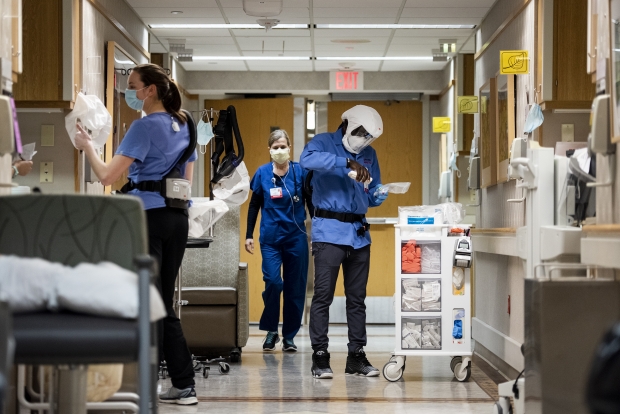Health Care Workers “Drained” by Pandemic
A new report finds a strained workforce after a year of the pandemic.

Healthcare workers pass through the hallway of a COVID-19 unit Tuesday, Nov. 17, 2020, at UW Hospital. Angela Major/WPR
As hospitals across Wisconsin look at ways to grow and retain staff, they face longstanding issues like an aging population which requires more medical care. Hospitals are also in the midst of unpacking a new problem in the wake of the coronavirus pandemic: how should the nation prepare and respond to public health emergencies and where do hospitals fit in?
A new report from the Wisconsin Hospital Association released Wednesday found that as public health departments became overwhelmed during the pandemic, hospitals had to step in and play a bigger role — taking on the role of contact tracers and testing facilities.
Testing was initially limited early in the pandemic because of supply, an issue that also slowed early vaccination efforts. Wisconsin expanded access to testing by designating community sites across the state. A similar method has put Wisconsin ahead of many states in its vaccination efforts — as of Tuesday, 22 percent of people in Wisconsin had received at least one dose of the vaccine.
And while the vaccine offers a glimpse of hope, health care workers are still dealing with the fallout of a stressful year.
According to the report, in the fall of 2020 hospitals and health systems were reporting that up to a quarter of their staff were quarantined due to close contact with an individual infected with COVID-19 or were at home in isolation because they were infected with the virus.
Hospital staff were also dealing with an uptick in cases that left some patients vying for a bed. During a November surge, Mayo Clinic Health System in northwestern Wisconsin put hospital beds in the lobby and in the ambulance garage to accommodate an overflow of patients.
Rising to the challenge of working at a hospital during a pandemic has left the health care workforce “drained,” the WHA report found. Long hours and a lack of the gear needed to keep workers safe has led to tense contract negotiations at some hospitals.
WHA’s report acknowledged there weren’t enough masks and other personal protective equipment for months after a pandemic was declared.
“Initially I think everyone didn’t know what was going to happen and the rules were to wear your mask indefinitely which many of us felt uncomfortable with for very scientific, well-educated reasons,” Cossel said.
Service Employees International Union (SEIU), of which Cossel is a member, has voted to authorize a possible strike for March 24.
Listen to the WPR report here.
Report: Pandemic Has Left Health Care Workforce ‘Drained’ was originally published by Wisconsin Public Radio.
More about the Coronavirus Pandemic
- Governors Tony Evers, JB Pritzker, Tim Walz, and Gretchen Whitmer Issue a Joint Statement Concerning Reports that Donald Trump Gave Russian Dictator Putin American COVID-19 Supplies - Gov. Tony Evers - Oct 11th, 2024
- MHD Release: Milwaukee Health Department Launches COVID-19 Wastewater Testing Dashboard - City of Milwaukee Health Department - Jan 23rd, 2024
- Milwaukee County Announces New Policies Related to COVID-19 Pandemic - David Crowley - May 9th, 2023
- DHS Details End of Emergency COVID-19 Response - Wisconsin Department of Health Services - Apr 26th, 2023
- Milwaukee Health Department Announces Upcoming Changes to COVID-19 Services - City of Milwaukee Health Department - Mar 17th, 2023
- Fitzgerald Applauds Passage of COVID-19 Origin Act - U.S. Rep. Scott Fitzgerald - Mar 10th, 2023
- DHS Expands Free COVID-19 Testing Program - Wisconsin Department of Health Services - Feb 10th, 2023
- MKE County: COVID-19 Hospitalizations Rising - Graham Kilmer - Jan 16th, 2023
- Not Enough Getting Bivalent Booster Shots, State Health Officials Warn - Gaby Vinick - Dec 26th, 2022
- Nearly All Wisconsinites Age 6 Months and Older Now Eligible for Updated COVID-19 Vaccine - Wisconsin Department of Health Services - Dec 15th, 2022
Read more about Coronavirus Pandemic here



















